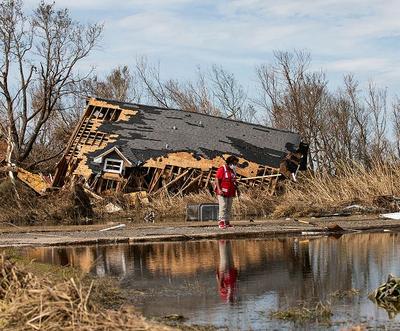
LAKE CHARLES, Louisiana, August 31, 2020 (ENS) – One of the 10 strongest hurricanes ever to make landfall in the United States, Hurricane Laura struck Louisiana in the middle of the night of August 26-27. Sustained winds of 150 mph ripped off roofs, knocked over trailer homes, and toppled trees and power lines.
Flooding from the Category 4 hurricane’s storm surge and heavy rain inundated areas many miles inland. Storm surges ranged from nine to 15 feet (three to five meters). The storm dropped five to 10 inches of rain on areas of Louisiana, Texas, and Arkansas, while winds wiped out electric power to hundreds of thousands of residents.

Hurricane historian Phil Klotzbach of Colorado State University said that Laura tied for the fifth strongest hurricane ever to make landfall in the continental United States. In terms of winds, Laura tied with the Last Island Hurricane of 1856 as the fifth-strongest hurricane on record in the country and as the strongest land-falling hurricane in Louisiana history.
But the cost in human lives has been what the National Atmospheric and Space Administration, NASA, calls “relatively low.”
Eighteen deaths have been reported in Louisiana and Texas. Half of those deaths have been attributed to carbon monoxide poisoning from generators, fired up when the power went out.
Louisiana Governor John del Edwards warned on Twitter, “If you are using a generator, please be safe. Most deaths from #Laura have been from improper usage of generators. Follow the manufacturer’s instructions, do not use them inside your home and keep them away from your windows and doors.”
In Port Arthur, Texas, three people are dead and 23 others were taken to hospital after possible carbon monoxide poisoning. The Jefferson County Office of Emergency Management said the group had a generator inside a building at a game room that did not have power in Port Arthur. Several are still in the hospital, although 16 have been released.
Today, there are still hundreds of thousands of families without power, potable water, medical supplies, safe shelter, and access to food.
As of the afternoon of August 31, more than 285,000 people in Louisiana were without electricity, with another 65,000 blacked out in Texas, according to NASA.
Calcasieu County and Beauregard County, which surround the city of Lake Charles, Louisiana, reported more than 120,000 citizens without power. Many also lacked running water. In the immediate aftermath of Laura, an estimated 900,000 people in the region are without electricity.
As of Friday, August 28, there were more than 543,000 power outages in Louisiana, stretching from southwest Louisiana through the central part of the state to north Louisiana. Another 209,000 residents are affected by water outages and many thousands more are displaced from their homes.
An estimated 500 electricity towers are down in the Lake Charles area and at least 17,000 linemen from across 29 states have arrived in Louisiana to help restore power.

Even so, it will take weeks for some residents to get their electricity back and it will take months to clean up the destruction that Hurricane Laura left.
The eye of the storm made landfall in a sparsely populated area just east of Calcasieu Ship Channel. Forecasters had warned of a potentially devastating storm surge up to 20 feet along the coast, and the channel might have funneled that water far inland. It did not.
NASA forecasters said, “The outcome was also a testament to strong forecasting and communication by the National Hurricane Center and local emergency management authorities in preparing the public for the hazards.”
Winds remained strong long after Hurricane Laura made landfall, destroying trees and power lines, smashing windows, and blowing off roofs. A gust of 137 miles per hour was measured in the city of Lake Charles, nearly 30 miles inland.
The storm sustained hurricane-force winds for nearly 10 hours after landfall when it was centered in Arkansas. Early estimates of property damage ranged from $4 billion to $30 billion according to various news media, with at least 8,000 homes lost or severely damaged.
Emergency response has been slow. Lake Charles residents are waiting more than four hours for basic supplies to be distributed by the U.S. military.
A chemical plant in Westlake, Louisiana that caught fire during Hurricane Laura Thursday morning was still burning Thursday evening.
The facility, BioLab Inc., makes chlorine for swimming pools. The Louisiana Department of Environmental Quality began monitoring the air quality when they arrived at the scene on Thursday, and the team’s initial readings did not detect any chlorine.
State Fire Marshall Butch Browning said no chlorine was detected in the air. “What they have found is no low-level detection of chlorine offsite, where people walk and where people gather — which is a good thing,” Browning said. “The cloud, the plume, as it goes in the air and moves out there is chlorine. Those chemicals are falling in the lake, which is the right place for it because it dilutes the chlorine. So that, we don’t believe, is endangering anyone.”
Browning said he is unaware of anyone reporting symptoms of chlorine gas exposure, which affects the respiratory system. The Governor’s Office of Homeland Security & Emergency Management issued a shelter-in-place advisory for residents nearby.
On Thursday, Governor Edwards traveled to southwest Louisiana to survey storm damage in Calcasieu, Cameron and Vermilion parishes. On Friday, he traveled to central and northern Louisiana to further survey storm damage, as Hurricane Laura retained strength and wind speed traveling through Louisiana.
Relief is on the way. People who sustained losses from Hurricane Laura in the designated parishes of Allen, Beauregard, Calcasieu, Cameron, Jefferson Davis and Vernon parishes can begin applying for assistance from the Federal Emergency Management Agency, FEMA, today by registering online at http://www.DisasterAssistance.gov or by calling 1-800-621-FEMA (3362) or 1-800-462-7585 (TTY) for the hearing and speech impaired. The toll-free telephone numbers will operate from 7 am to 10 pm (local time) seven days a week until further notice.
The Governor’s office says additional parishes may be added to this declaration by FEMA, as damage assessments are ongoing.
The Red Cross says that more than 1,300 trained disaster workers have been mobilized to support relief efforts on the ground or virtually. Teams of volunteers are circulating through accessible areas to assess the damage and provide ready-to-eat meals, and water.
Thousands of people showed up over the weekend at service sites set up by the Red Cross and its partners in Calcasieu and Beauregard parishes to get water, food, and emergency relief supplies. With the help of partners, the Red Cross has already served more than 24,000 meals and snacks.
Red Cross workers are also helping to replace prescription medications, eyeglasses and offer emotional support to people whose lives have been turned upside down. And the Red Cross is working with the World Central Kitchen, the Salvation Army, and the Southern Baptist Convention to set up kitchens, which are able to serve tens of thousands of meals each day.
On Sunday night, various agencies helped about 20,000 people stay in emergency lodgings, including shelters and, in some instances, hotels. As people are allowed to return back to their local communities after evacuating, the Red Cross will work with its partners to help ensure they have a safe place to go.
Copyright Environment News Service (ENS) 2020. All rights reserved.



